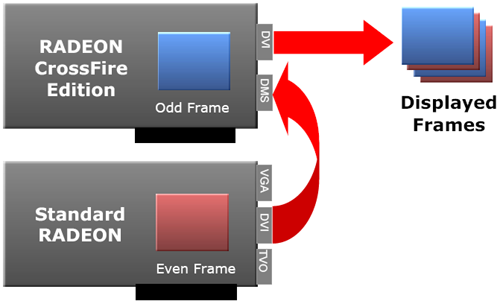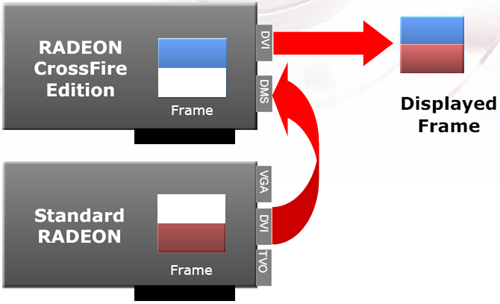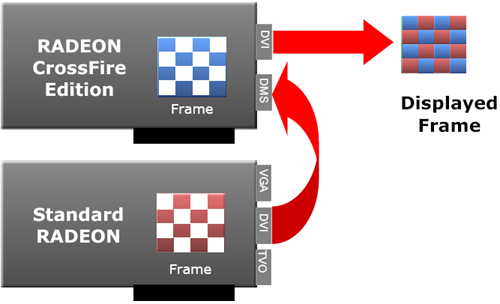ATI's Multi-GPU Solution: CrossFire
by Anand Lal Shimpi & Derek Wilson on May 30, 2005 9:00 PM EST- Posted in
- GPUs
Rendering Modes
The task of getting two separate video cards to handle drawing frames efficiently for a single application transparent to the programmer and end user is quite an undertaking. When life was fillrate limited, 3dfx solved the problem by having each card render odd and even scanlines, which were then combined in analog. This solution is no longer viable, but ATI and NVIDIA have both come up with ways to accomplish the goal.The absolute most desirable mode of operation that both companies have come up with is alternate frame rendering (AFR). As the name implies, each card renders an entire, separate frame. The major advantage to allowing each card to render an entire frame is that each card is able to handle the geometry processing required as well as the pixel processing.

Alternate frame rendering can't always be used for various reasons (such as the case when one frame depends on the previous result). When alternate frame rendering cannot be used, splitting the current frame vertically is an alternative that both ATI and NVIDIA have implemented. When the work for a single frame is split between two cards, the geometry pipeline can't be divided as easily as the pixel pipeline. As a scene is being rendered, it is not easy to assign objects to different cards as all objects in a scene can affect any of the pixels.

After geometry is sorted, a guess can be made as to how much pixel power will be required for different areas of the screen, and NVIDIA takes advantage of this to distribute the workload more evenly across the two cards. If the top half of the screen isn't as difficult to render, more than half the screen is given to the card assigned to the top. This method definitely helps to keep cards rendering split frames evenly loaded. ATI is capable of splitting the rendering work 60/40 or 70/30 under their scissor mode, but the split is determined per application.

Evenly dividing work is a very important task, and ATI has taken it a step further with CrossFire. They are introducing a rendering mode, which they call Supertiling. This mode splits the entire screen up into 32x32 pixel tiles and hands out a checkerboard pattern to each graphics card for pixel processing. Doing this effectively takes the guess work out of load balancing pixel processing between two cards. The workload averages itself out when the cards share the pixels in areas so near each other.
The caveat of Supertiling is compatibility. It has come to our attention that the "small number of applications" for which Supertiling does not work includes all OpenGL based titles. This means that OpenGL has either AFR or split frame rendering options available. AFR is the most desirable mode, but it would be nice to have a middle ground with more effective load balancing.
In addition to these multi card render modes, ATI has gone a step further to include enhanced AA modes. This is made possible by taking advantage of programmable sample points and their hardware compositing engine.










57 Comments
View All Comments
Panndor - Monday, June 13, 2005 - link
Lets hope that this endevor by ATI doesn't end up in the same situation at the RAGE Fury Maxx they came up with. The last time they tried this they screwed it up and then cut support for the card like it never existed.Looks promising, but I could see problems if they allow different hardware to run in a combined mode as well.
Competition is good so maybe this will bring down the price of the boards and the cards now.
vision33r - Wednesday, June 1, 2005 - link
Those 2 X850XT PE cards add up to $1000+ alone while price of 6800U are going down.I think the biggest prob is not if this works or not, is if the mainboard performance is sacrificed due to the ATI north-bridge. I don't gave 90% of the time on my system, I can't sacrifice losing system performance for gaming perf.
xsilver - Wednesday, June 1, 2005 - link
what's funny is that a few months after the xfire is released, nvidia will probably announce SLI v2.0 and then everyone will talk about how that's so coolWesley Fink - Wednesday, June 1, 2005 - link
#49 & #50 - The Uli 1573 we've seen paired with Crossfire DOES suport NCQ. this was confirmed this afternoon with engineers here at Computex. The upcoming ULI 1575 southtridge supports both Sata 2 and NCQ.We also saw demos of Splinter Cell on Crossfire with the 2.0 Shader. The demos were at 1280x1024 with all eye candy enabled. Frame rates in the various demos were 118 to 120. Since we did not have reference benches for Splinter Cell, it didn't make much sense to publish these results in the launch article. What we have seen is very promising, but we need more "hands-on" benchmarking before we can say much more.
Wesley Fink
mkruer - Wednesday, June 1, 2005 - link
#51 That is the real question to be answered. My guess is that ATI will work on a SLI board and visa versa unless there is something specifically in hard coded that prevents the second slot from being used by anything other the chipsets manufactures video card, which is highly unlikely. From the BIOS and driver standpoint the MB is either has 1x16 PCIex slot or 2x8 PCIex slots.elecrzy - Tuesday, May 31, 2005 - link
its possible to have Crossfire work on the NF4/945/955. Its just that ATI won't support them through the drivers. Sigh...kmmatney - Tuesday, May 31, 2005 - link
Does the ULi southbridge have NCQ support?weblizard - Tuesday, May 31, 2005 - link
No Sata II or NCQ support. That's all I need to know to NOT want a crossfire system.bob661 - Tuesday, May 31, 2005 - link
#47I had the Abit board with the AMD chipset on it. Worked flawlessly. I gave it to a friend when I upgraded that box and it was running until last year when he upgraded his box.
sprockkets - Tuesday, May 31, 2005 - link
26# That was the 760MPX or the dual processor chipset. Don't recall any irongate issues (that was 750, 760 was the DDR version, right?)